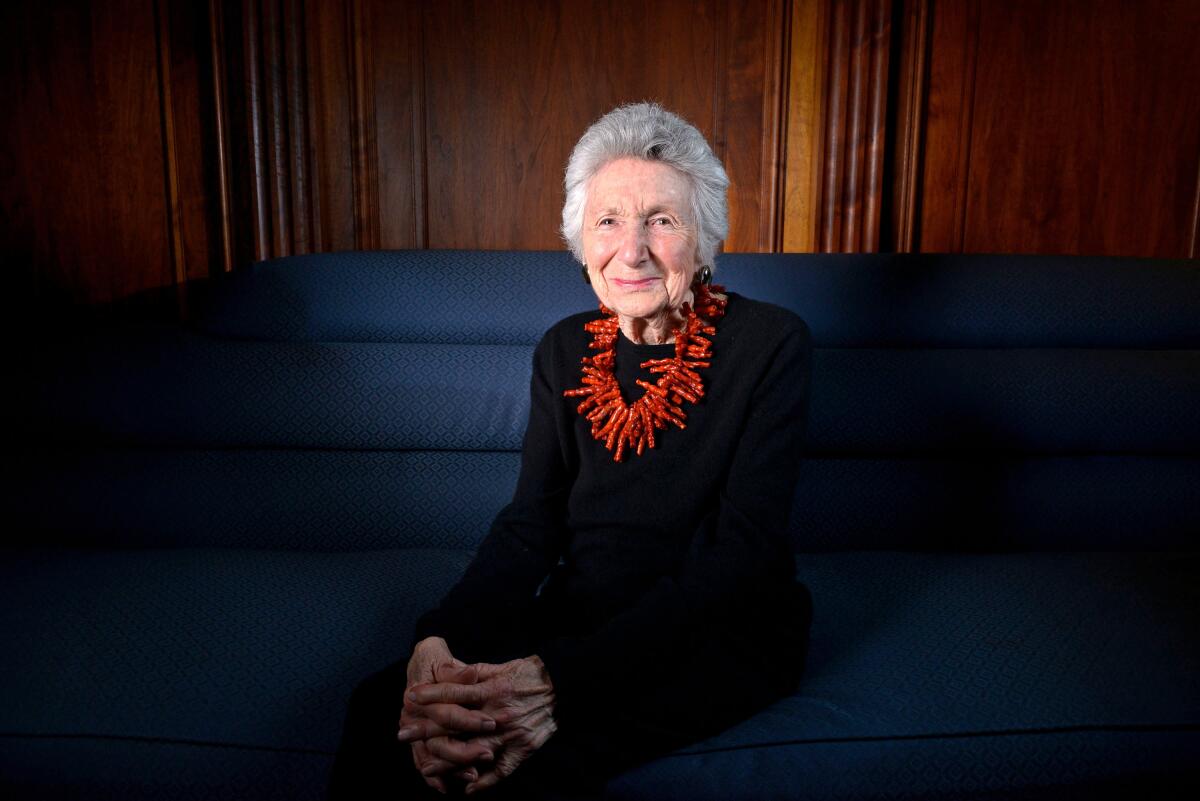Marcia Nasatir, the first female VP of a major studio, was a trailblazer and a ‘Classy Broad’

Knowledgeable film buffs are probably aware that women worked behind the scenes in Hollywood as far back as the silent era. Female directors, screenwriters, editors, even a few producers contributed to movies. Studio executive suites, however, were an exclusive boys’ club for decades. A few talented women finally broke through the glass ceiling, and one of the pioneers — Marcia Nasatir — died Aug. 3 at the age of 95. Though she became the first female vice president at a major studio during her time with United Artists, she was not as well known as some of the women who came after her, like Sherry Lansing, Dawn Steel and Amy Pascal. But she helped to pave the way for all of them.
I knew Marcia for more than 40 years, since she began working for the Ziegler Diskant agency in the 1970s. She always struck me as smart, feisty, outspoken, but never arrogant. She grew up in San Antonio, Texas, moved to New York, where she raised two sons on her own and also worked as a literary agent and book editor. One of her closest friends from her New York days was trailblazing movie critic Pauline Kael.They retained their ties after Marcia moved to Los Angeles. In fact, when the Los Angeles Film Critics Assn. decided to give a special award to Kael in the late 1990s, it was Nasatir who accepted the award for her.
In 1974, Marcia had become vice president at UA, where she helped to shepherd such films as “One Flew Over the Cuckoo’s Nest,” “Rocky,” “Carrie,” “Invasion of the Body Snatchers” and “Coming Home” — Jane Fonda even thanked Nasatir when she accepted the Oscar for her starring role in the 1978 film. When the top executives at UA left to form Orion Pictures that same year, Nasatir was not invited to join them in the executive suites. Instead she worked as an executive at other companies and produced such films as “The Big Chill,” “Ironweed” and “Hamburger Hill.”
After her producing career slowed, Nasatir found a new identity as a film critic on a 2007 YouTube show called “Reel Geezers,” in which she jousted with her friend and former client, screenwriter Lorenzo Semple Jr. (“Batman” TV series, “Pretty Poison,” “Three Days of the Condor”). The show grew out of informal arguments that the two of them had over the years; they decided to take their arguments to the airwaves, and their show (sort of a prepodcast) found a lot of enthusiastic followers, including directors Tony Gilroy and Wes Anderson. Both of the geezers were feisty and iconoclastic, though Semple sometimes teased Nasatir for being too politically correct. For example, she hated the trash-talking teen comedy “Superbad” because of its demeaning attitude toward women; he loved its grossness and irreverence.
Nasatir was also an active member of the executive committee weeding through the contenders for the foreign-language Oscar. She usually took the bus to the film academy screenings. When I once asked her how she felt about the frequent criticisms directed at the academy’s international film nominees, she replied acerbically, “You know, this isn’t kindergarten where everybody gets a prize. You have to make tough choices.”
In 2016, Nasatir starred in her own movie, a charming documentary called “A Classy Broad,” directed by Anne Goursaud. Goursaud had met Nasatir at a yard sale in 1980, and the two struck up an easy friendship. Nasatir also aided Goursaud’s career. According to Goursaud, “She introduced me to [producer] Fred Roos and the Coppolas,” and Goursaud was hired to edit Francis Coppola’s “One From the Heart” and “Dracula.” When she made “A Classy Broad,” Goursaud returned the favor. The film paid tribute to Marcia’s many achievements; it incorporated interviews with screenwriter Robert Towne, “Big Chill” director Lawrence Kasdan and one of the film’s stars, Glenn Close, along with family members, including Nasatir’s sister, a judge on the Texas Supreme Court. Another person interviewed was former Nixon lawyer John Dean, who had been Marcia’s client when Dean wrote his political expose, “Blind Ambition.”
“A Classy Broad” put me in closer touch with Marcia during the last few years. I went to her 90th birthday party, and she invited me to several other events at her Brentwood apartment. She hosted celebrations for the San Antonio Film Festival, several authors and a number of foreign dignitaries; the company was always engaging. At one of the events I met Justin Henry, who many years earlier had played the 6-year-old son of Dustin Hoffman and Meryl Streep in “Kramer vs. Kramer.” I invited Justin to speak at our 40th anniversary screening of the movie in 2019, and he very much wanted Marcia to be in the audience. She was planning to attend but had an attack of shingles that prevented it. She wrote to me, “Devastated to miss you and the Kramers. The film remains a treasured memory for me.”
We tried to set up a lunch instead, but her health didn’t allow it at the time. Then after the pandemic hit, I lost touch with her — and with many others. But I feel fortunate to have shared so many enjoyable encounters with one of the classiest people — OK, classiest broads — ever to call the shots in Hollywood.
More to Read
Only good movies
Get the Indie Focus newsletter, Mark Olsen's weekly guide to the world of cinema.
You may occasionally receive promotional content from the Los Angeles Times.










